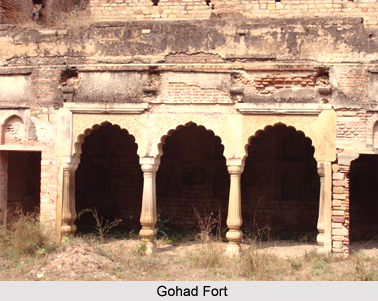 Gohad Fort is an ancient fort which is located in Gohad in the district of Bhind, Madhya Pradesh. The geographical coordinates are latitude 26 degree 25` 34N and longitude 78 degree 26` 41E. It is situated almost 45 km away from Gwalior.
Gohad Fort is an ancient fort which is located in Gohad in the district of Bhind, Madhya Pradesh. The geographical coordinates are latitude 26 degree 25` 34N and longitude 78 degree 26` 41E. It is situated almost 45 km away from Gwalior.
History of Gohad Fort
The Gohad Fort was founded in 1505 by a Jat ruler named Rana Singhandev II. The town of Gohad became a stronghold for the Jat caste, after from Bamrauli they settled in the region in 1505. The state of Gohad was also established along with the fort. It includes various significant monuments constructed by the Jat rulers. The Rajput ruler of Bhadawar, Umara-I-Uzzam Maharaja Mahendra Gopal Singh Bhadauria occupied Gohad Fort in 1708.
Architecture of Gohad Fort
The fort was constructed in a circular shape and was established near the Vaisli River for strategic purposes. It is guarded by a barricade which was built around Gohad Fort. The Vaisli River was excavated and the flow of the river water was stretched up to the fort which resulted in a semi-circular shape. The ancient fort consists of 11 gates. The names of the gates were based on the villages they faced, such as, Saraswati, Kharaua in southeast, Kathwan in east, Birkhari in northeast, Gohadi in northwest, Barthara in west and Itayli in south.
Gohad Fort was established by 4 separate lines of defence that guarded the structure. The initial line of defence was an external barricade with a height of 10 metre. It was bounded by a trench. The second line of defence was created by depositing soil inside the external barricade which was dug out from the trench. The third defensive line was a pucca or solid trench with a higher wall that was 1 km long. The wall was protected by the Vaisli River and a pond known as Laxman Tal. The defensive wall included 2 entrances whioch were known as Sankal gate in the west and Hathai paur in the east. The fourth line of defence was another strong and high wall. It was constructed for the safety of the ruler and his assets.
The fort at Gohad was constructed by the use of local stones and rocks, bricks and lime mortar. Although the fort was established by Rana Singhandev II, most of the construction was carried out by Maharaja Bhim Singh Rana, Maharaja Kirat Sing and Maharaja Chhatra Singh.
Gohad Fort includes several important structures inside its premises, namely Navin Mahal, Rani Bagh, Bhandar Griha, Am Darbar, Khas Darbar, Deoghar, Sat Bhanwar, Shish Mahal and Khas Mahal. The Navin Mahal is the most beautiful structure in the fort. It was built by Maharana Chhatra Singh. The building includes several offices such as Diwane Khas and Diwane Am. The specialty of the structure was a rounded and gently sloped ramp through which the ruler could go the top floor while riding on a horse.
There are many temples in the vicinity, such as, Markandeshwar temple, Lord Rama Janaki temple, Lord Shiva temple, Radha Krishna temple and Laxman temple. Some of the water tanks or ponds in the fort were Laxman Tal, Bhimsagar, Ramsagar and others.



















